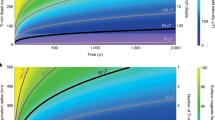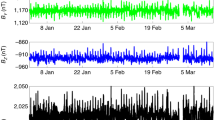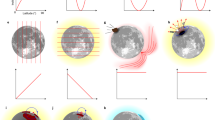Abstract
In contrast to our detailed knowledge of the directional behaviour of the Earth's magnetic field during geological and historical times1,2, data constraining the past intensity of the field remain relatively scarce. This is mainly due to the difficulty in obtaining reliable palaeointensity measurements, a problem that is intrinsic to the geological materials which record the Earth's magnetic field. Although the palaeointensity database has grown modestly over recent years3,4,5 these data are restricted to a few geographical locations and more than one-third of the data record the field over only the past 5?Myr—the most recent database5 covering the time interval from 5 to 160?Myr contains only about 100 palaeointensity measurements. Here we present 21 new data points from the interval 5–160?Myr obtained from submarine basalt glasses collected from locations throughout the world's oceans. Whereas previous estimates for the average dipole moment were comparable to that of the Earth's present field6, the new data suggest an average dipole moment of (4.2 ± 2.3) × 1022?A?m2, or approximately half the present magnetic-field intensity. This lower average value should provide an important constraint for future efforts to model the convective processes in the Earth's core which have been responsible for generating the magnetic field.
This is a preview of subscription content, access via your institution
Access options
Subscribe to this journal
Receive 51 print issues and online access
$199.00 per year
only $3.90 per issue
Buy this article
- Purchase on Springer Link
- Instant access to full article PDF
Prices may be subject to local taxes which are calculated during checkout


Similar content being viewed by others
References
Opdyke, N. D. & Channell, J. E. T. Magnetic Stratigraphy (Academic, San Diego, (1996)).
Merrill, R. T., McElhinny, M. W. & McFadden, P. L. Paleomagnetism, the Core, and the Deep Mantle (Academic, San Diego, (1996).
McFadden, P. L. & McElhinny, M. W. Variations in the geomagnetic dipole 2: statistical analysis of VDM's for the past 5?m.y. J. Geomagn. Geoelectr. 34, 163–189 (1982).
Tanaka, H., Kono, M. & Uchimura, H. Some global features of paleointensity in geological time. Geophys. J. Int. 120, 97–102 (1995).
Perrin, M. & Shcherbakov, V. Paleointensity of the Earth's magnetic field for the past 400Ma: evidence for a dipole structure during the Mesozoic low. J. Geomagn. Geoelectr. 49, 601–614 (1997); data available by anonymous ftp at 〈ftp://ftp.ngdc.noaa.gov〉 (cited 17 July (1998)).
Merrill, R. T. & McElhinny, M. W. The Earth's Magnetic Field (Academic, San Diego, (1983)).
Pick, T. & Tauxe, L. Holocene paleointensities: Thellier experiments on submarine basaltic glass from the East Pacific Rise. J. Geophys. Res. 98, 17949–17964 (1993).
Pick, T. & Tauxe, L. Characteristics of magnetite in submarine basaltic glass. Geophys. J. Int. 119, 116–128 (1994).
Pick, T. & Tauxe, L. Geomagnetic paleointensities during the Cretaceous normal superchron measured using submarine basaltic glass. Nature 366, 129–139 (1993).
Thellier, E. & Thellier, O. Sur l'intensité du champ magnétique terrestre dans le passé historique et géologique. Ann. Geophys. 15, 285–378 (1959).
Coe, R. S., Grommé, S. & Mankinen, E. A. Geomagnetic paleointensities from radiocarbon-dated lava flows on Hawaii and the question of the Pacific nondipole low. J. Geophys. Res. 83, 1740–1756 (1978).
Kirschvink, J. L. The least-squares line and plane and the analysis of paleomagnetic data. Geophys. J. R. Astron. Soc. 62, 699–718 (1980).
Van der Voo, R. Paleomagnetism of the Atlantic, Tethys and Iapetus Oceans (Cambridge Univ. Press, (1993)).
Steiner, M. B. Paleomagnetism of the Cretaceous section, Site 462. Init. Rep. DSDP 61, 711–716 (1981).
Clube, T. M. M., Creer, K. M. & Robertson, A. H. F. Paleorotation of the Troodos microplate, Cyprus. Nature 317, 522–525 (1985).
Mueller, R. D., Royer, J.-Y. & Lawver, L. A. Revised plate motions relative to the hotspots from combined Atlantic and Indian Ocean hotspot tracks. Geology 21, 275–278 (1993).
Lee, T.-Y. & Lawver, L. A. Cenozoic plate reconstruction of Southeast Asia. Tectonophysics 251, 85–138 (1995).
Gripp, A. & Gordon, R. Plate velocities relative to hot spots. Geophys. Res. Lett. 17, 1109–1112 (1990).
Mejia, V., Opdyke, N. D. & Perfit, M. R. Paleomagnetic field intensity recorded in submarine basaltic glass from the East Pacific Rise, the last 69?ka. Geophys. Res. Lett. 23, 475–478 (1996).
Prévot, M., Mankinen, E. A., Coe, R. S. & Grommé, C. S. The Steens Mountain (Oregon) geomagnetic polarity transition 2. Field intensity variations and discussion of reversal models. J. Geophys. Res. 90, 10417–10448 (1985).
Bleil, U. & Petersen, N. Variations in magnetization intensity and low-temperature titanomagnetite oxidation of ocean floor basalts. Nature 301, 384–388 (1983).
Prévot, M., Derder, M. E. M., McWilliams, M. & Thompson, J. Intensity of the Earth's magnetic field: evidence for a Mesozoic dipole low. Earth Planet. Sci. Lett. 97, 129–139 (1990).
Johnson, H. P. & Tivey, M. A. Magnetic properties of zero-age oceanic crust; a new submarine lava flow on the Juan de Fuca ridge. Geophys. Res. Lett. 22, 175–178 (1995).
Kent, D. V. & Gee, J. Magnetic alteration of zero-age oceanic basalt. Geology 24, 703–706 (1996).
Dunlop, D. J. & Özdemir, Ouml;. Rock Magnetism: Fundamentals and Frontiers (Cambridge Univ. Press (1997)).
Raymond, C. & LaBrecque, J. L. Magnetization of the oceanic crust: thermoremanent magnetization or chemical remanent magnetization? J. Geophys. Res. 92, 8077–8088 (1987).
Johnson, H. P. & Pariso, J. E. Variations in oceanic crustal magnetization: Systematic changes in the last 160 million years. J. Geophys. Res. 98, 435–445 (1994).
Cande S. C. & Kent, D. V. Ultrahigh resolution marine magnetic anomaly profiles: a record of continuous paleointensity variations? J. Geophys. Res. 97, 15075–15083 (1992).
Gee, J., Schneider, D. A. & Kent, D. V. Marine magnetic anomalies as recorders of geomagnetic intensity variations. Earth Planet. Sci. Lett. 144, 327–335 (1996).
Johnson, H. P., Vanpatten, D. & Sager, W. W. Age-dependent variation in the magnetization of seamounts. Geophys. Res. Lett. 22, 231–234 (1995).
Tauxe, L. & Hartl, P. 11 million years of Oligocene geomagnetic field behaviour. Geophys. J. Int. 128, 217–229 (1996).
Gee, J. & Kent, D. V. Magnetization of axial lavas from the southern East Pacific Rise (14 degrees–23 degrees S): Geochemical controls on magnetic properties. J. Geophys. Res. 10, 24873–24886 (1997).
Castillo, P. R., Pringle, M. S. & Carlson, R. W. East Mariana Basin tholeiites: Cretaceous intraplate basalts or rift basalts related to the Ontong Java plume? Earth Planet. Sci. Lett. 123, 139–154 (1994).
Mukasa & Ludden Geology 15, 825 (1987).
Harland, W. B. et al. A Geologic Time Scale (Cambridge Univ. Press, (1989)).
Cande, S. C. & Kent, D. V. Revised calibration of the geomagnetic polarity timescale for the Late Cretaceous and Cenozoic. J. Geophys. Res. 100, 6093–6095 (1995).
Acknowledgements
This work was supported in part by the NSF and GOA.
Author information
Authors and Affiliations
Corresponding author
Supplementary Information
Rights and permissions
About this article
Cite this article
Juárez, M., Tauxe, L., Gee, J. et al. The intensity of the Earth's magnetic field over the past 160 million years. Nature 394, 878–881 (1998). https://doi.org/10.1038/29746
Received:
Accepted:
Issue Date:
DOI: https://doi.org/10.1038/29746
This article is cited by
-
Geomagnetic paleointensity dating of mid-ocean ridge basalts from the neo-volcanic zone of the Central Indian Ridge
Earth, Planets and Space (2024)
-
Paleointensity of the Earth's magnetic field at \( \sim \)117 Ma determined from the Rajmahal and Sylhet Trap Basalts, India
Journal of Earth System Science (2021)
-
Low geomagnetic field strength during End-Cretaceous Deccan volcanism and whole mantle convection
Scientific Reports (2020)
-
A paleointensity study of Cretaceous volcanic rocks from the Western Cordillera, Colombia
Studia Geophysica et Geodaetica (2017)
-
The Magnetic Field of Planet Earth
Space Science Reviews (2010)
Comments
By submitting a comment you agree to abide by our Terms and Community Guidelines. If you find something abusive or that does not comply with our terms or guidelines please flag it as inappropriate.



